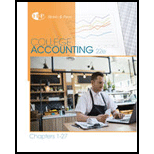
Concept explainers
Screpcap Co. had the following transactions during the first week of June:
June 1 Purchased merchandise on account from Acme Supply, $2,700, plus freight charges of $160.
1 Issued Check No. 219 to Denver Wholesalers for merchandise purchased on account, $720, less 1% discount.
1 Sold merchandise on account to F. Colby, $246, plus 5% state sales tax plus 2% city sales tax.
June 2 Received cash on account from N. Dunlop, $315.
2 Made cash sale of $413 plus 5% state sales tax plus 2% city sales tax.
2 Purchased merchandise on account from Permon Co., $3,200, plus freight charges of $190.
3 Sold merchandise on account to F. Ayres, $211, plus 5% state sales tax plus 2% city sales tax.
3 Issued Check No. 220 to Ellis Co. for merchandise purchased on account, $847, less 1% discount.
3 Received cash on account from F. Graves, $463.
4 Issued Check No. 221 to Penguin Warehouse for merchandise purchased on account, $950, less 1% discount.
4 Sold merchandise on account to K. Stanga, $318, plus 5% state sales tax plus 2% city sales tax.
4 Purchased merchandise on account from Mason Milling, $1,630, plus freight charges of $90.
4 Received cash on account from O. Alston, $381.
5 Made cash sale of $319 plus 5% state sales tax plus 2% city sales tax.
5 Issued Check No. 222 to Acme Supply for merchandise purchased on account, $980, less 1% discount.
Required
- 1. Record the transactions in a general journal.
- 2. Assuming these are the types of transactions Screpcap Co. experiences on a regular basis, design the following special journals for Screpcap:
- (a) Sales journal
- (b) Cash receipts journal
- (c) Purchases journal
- (d) Cash payments journal
Want to see the full answer?
Check out a sample textbook solution
Chapter 12 Solutions
College Accounting, Chapters 1-27
 College Accounting, Chapters 1-27AccountingISBN:9781337794756Author:HEINTZ, James A.Publisher:Cengage Learning,Principles of Accounting Volume 1AccountingISBN:9781947172685Author:OpenStaxPublisher:OpenStax College
College Accounting, Chapters 1-27AccountingISBN:9781337794756Author:HEINTZ, James A.Publisher:Cengage Learning,Principles of Accounting Volume 1AccountingISBN:9781947172685Author:OpenStaxPublisher:OpenStax College Financial AccountingAccountingISBN:9781337272124Author:Carl Warren, James M. Reeve, Jonathan DuchacPublisher:Cengage Learning
Financial AccountingAccountingISBN:9781337272124Author:Carl Warren, James M. Reeve, Jonathan DuchacPublisher:Cengage Learning College Accounting (Book Only): A Career ApproachAccountingISBN:9781337280570Author:Scott, Cathy J.Publisher:South-Western College Pub
College Accounting (Book Only): A Career ApproachAccountingISBN:9781337280570Author:Scott, Cathy J.Publisher:South-Western College Pub College Accounting (Book Only): A Career ApproachAccountingISBN:9781305084087Author:Cathy J. ScottPublisher:Cengage Learning
College Accounting (Book Only): A Career ApproachAccountingISBN:9781305084087Author:Cathy J. ScottPublisher:Cengage Learning




